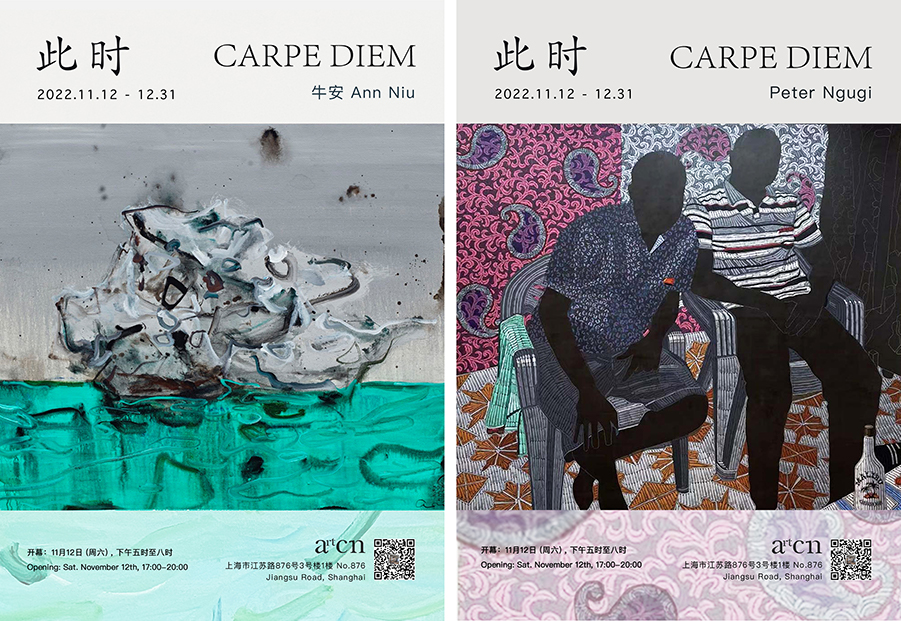
Ann Niu, Peter Ngugi
As this year marks ArtCN’s 10th anniversary, we are continuing our mission of nurturing dialogues in art and culture between artists from China and those abroad. With these two independent yet complimentary exhibitions, we are showing the works of Shanghai-born artist Ann Niu, who has been with our gallery since its inauguration, and Peter Ngugi from Kenya, whom we welcome here for his first solo exhibition in China. Coincidentally, both artists have chosen the title Carpe Diem for their show, reminding us that in times of challenges and uncertainty, we always need to seize the day.
In Carpe Diem, we are showing the works of Shanghai-born artist Ann Niu and Peter Ngugi from Kenya.
Ann Niu’s selection of works covers three of her favourite themes: Scholar stones, Silhouettes and her Dream series. Ann Niu uses graceful, calligraphic lines enhanced by vibrant and auspicious colours to achieve a striking visual effect, which in her artistic language speaks about the fragility but resilience of human nature. In Peter Ngugi’s work, silhouettes, devoid of any features, are set against a colourful and flowery background. The contrast and separation of colours and strokes are metaphorical of individuality and coexistence. These strokes are a depiction of the diverse tribal and cultural mix in contemporary Kenyan society.
“As a painter, Ann Niu began her artistic career by learning calligraphy. Calligraphy is all about quality of strokes, that is, lines and texture, and lines later became the most critical and distinctive elements in her paintings. The Oriental culture emphasizes "metaphor" and "blank space", which Ann appreciates. Calligraphy provides her with endless inspiration. Strokes outline the subject of her expression; meanwhile, symbols and even lines are used as allusion. These can leave a space for association, and also add a sense of rhythm and mystery to her works. In the abstract feast composed of lines and symbols, her work is like a grand and beautiful decoding game of love. As she says, ‘In this era of public social networks everywhere, our love must be encrypted to be fun, right?’
‘My second calligraphy teacher once told me that your calligraphy is your universe, the radicals of the characters are two people, and they are fighting against each other, but they have to stand firm. The inspiration for me is to know where to leave white space and where to be heavy when drawing. In fact, at the end of the day, I use lines to walk.
Our drawing practice starts from drawing the curves of people, just like wood carving or sculpture is also first cut into a square and then it gets rounded out. In fact, every bone in a human's body is curved and has curves, so they are beautiful. I don't really like to define my own style, but I think it is more important to have a resemblance than a shape.’"
—— Excerpt from Women in Motion, an interview of Ann Niu for Kering, 2022
In Peter Ngugi's work, the umber silhouettes are all based on real people. The background is like a metaphor for the basic accommodations of the subject's family. Peter explains, "The fabric room divider was an important centerpiece. The motifs were carefully selected. These elements and motifs form integral backdrops for my portraits. Theses functional installations are a focal point in my work. The strong presence of traditional and contemporary African design is deliberately employed in the narration of this African story."
"Real characters appear in fictitious compositions and imagined spaces. The silhouettes present a mystery: the anonymity of good and bad. When people come to my studio and look at the silhouettes, they are tempted to think that maybe these are people they already know or have met before. Their identities are hidden yet they look straight into the viewer, their eyes silent.
The silhouettes reveal a combination of traditional Kenyan design with western design. Often outdated trends show up again in contemporary fashion and popular culture. My work tends to explore collective memories in our modern society and interrogates the relevance of telling these stories to the world."
——Peter Ngugi